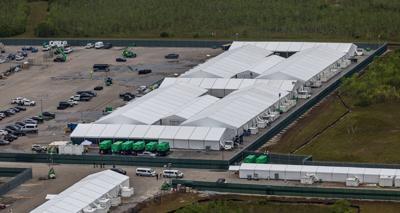Surrounded by the low hum of swamp bugs, Anthony Sleiman pointed his camera to the west.
The conservation photographer was more than 15 miles from the stateŌĆÖs newly built immigrant detention center, dubbed . But just before 10 p.m. on July 1, he could see the siteŌĆÖs glow with his naked eye.
Sleiman, whose night-sky Everglades images were featured last year in the national parkŌĆÖs visitor center, is concerned that the industrial lights emitting from the facility could harm the protected wildlife in a preserve globally recognized for its dark skies.
HeŌĆÖs not alone: The leading international authority that certifies ŌĆ£dark skyŌĆØ parks says the artificial light from Alligator Alcatraz ŌĆ£directly threatensŌĆØ the preserveŌĆÖs renowned natural darkness and disrupts endangered nocturnal wildlife.
People are also reading…
ItŌĆÖs one of the latest environmental and human rights concerns stemming from the , Florida.

Aerial view of structures, including gigantic tents built at the recently opened migrant detention center, ŌĆ£Alligator Alcatraz,ŌĆØ located at the site of the Dade-Collier Training and Transition Airport in Ochopee, Florida, on July 4.
After a rigorous process with the U.S. National Park Service, DarkSky International in 2016 designated FloridaŌĆÖs Big Cypress National Preserve as the nationŌĆÖs first preserve to achieve ŌĆ£dark skyŌĆØ status, meaning itŌĆÖs home to one of the last remaining reservoirs of darkness unimpeded by the glow of human development.
But the stateŌĆÖs detention center, built for , runs counter to the preserveŌĆÖs commitment to protecting the darkness many species rely on, the group said.
ŌĆ£The development represents a significant step backward for dark sky conservation efforts in a region where considerable resources have been invested in Everglades restoration,ŌĆØ the group said in a statement to the Tampa Bay Times.
ŌĆ£Protecting the natural night environment is an integral part of broader ecosystem health and resilience.ŌĆØ
Night-sky images from the past week taken by┬Āphotographers like Sleiman and environmental advocates appear to depict the facilityŌĆÖs glow more than a dozen miles from the site. Satellite imagery from NASA also shows the facility standing out amid dark wilderness on all sides.
Whether Big Cypress could keep its designation as a ŌĆ£dark skyŌĆØ preserve depends on an annual review of light pollution data, according to Ruskin Hartley, executive director of DarkSky International.
Big Cypress is revered by astronomers, photographers and parkgoers as a nighttime sanctuary from the light pollution emitting from Miami to the east and Naples to the west. The park service with phrases like ŌĆ£Half the park is after dark!ŌĆØ
Detainees of Alligator Alcatraz, they are enduring inhumane conditions at the site, said the lights are on at the facility at all times. Critics of the detention facility have argued that not only is it cruel to house detainees in the heat of the swamp, but the state and federal government have also brushed aside environmental laws protecting the park.
In a court filing last week, suing local, state and federal officials to stop activity at the detention center underscored what they called violations of environmental law and argued the night sky over Big Cypress ŌĆ£now glows like Yankee Stadium, visible from 15-miles away.ŌĆØ
The two advocacy groups, Friends of the Everglades and the Center for Biological Diversity, say the artificial lighting is defiling the night sky, harming public enjoyment and disrupting the habitat of species that thrive at night.
For one, the Florida bonneted bat, an exceedingly rare species living in habitat around the detention center, relies on the cover of night to hunt and can be deterred by artificial lights. Florida panthers, too, are more active at night, and FloridaŌĆÖs wildlife agency considers light pollution a form of habitat loss.
Officials have not responded to questions from the Times about the stateŌĆÖs lighting at the facility, including whether thereŌĆÖs any consideration for adhering to the preserveŌĆÖs dark sky designation.
Videos from June 26 show industrial flatbed trucks shuttling what appear to be Sunbelt temporary lighting structures into the entrance of the detention center, according to footage taken by Jessica Namath, founder of the advocacy group Floridians for Public Lands.
It wasnŌĆÖt easy for Big Cypress National Preserve to become the nationŌĆÖs first ŌĆ£dark skyŌĆØ park in 2016: Staff had to retrofit hundreds of light fixtures and create guidelines for when and where lights could be turned on at night.
In its application, the park service noted the presence of the Dade-Collier Training and Transition Airport within the preserveŌĆÖs boundaries ŌĆö the site where the detention center now stands.
The only night use for the airport, staff wrote, would be emergency landings, and there hadnŌĆÖt been one in 25 years.
ŌĆ£There are no plans to expand or change the layout or usage of the (airport),ŌĆØ staff wrote at the time.
John Barentine, who oversaw the dark sky program when Big Cypress was being considered, said the airportŌĆÖs current use, with lighting surrounding the detention facility, would have likely disqualified the preserve from being named a dark sky park.
ŌĆ£It wouldŌĆÖve been a problem,ŌĆØ Barentine said.
He compared the situation to Mammoth Cave National Park in Kentucky. When that park applied to be named a dark sky park, lighting from a Job Corps center drew out the process for years.
DarkSky International said in its statement that the construction of the detention facility ŌĆ£demands the most rigorous application of dark-sky friendly lighting principles.ŌĆØ Since 1988, the group has designated about 200 places across the world that work to fend off light pollution.
ŌĆ£A lot of people think the Everglades goes to sleep at sunset, but thatŌĆÖs not true. ThatŌĆÖs when itŌĆÖs waking up,ŌĆØ Sleiman said.
But now, dusk also awakens the lights of what looks like a baseball stadium from afar.
ŌĆ£I want people to know the Everglades is one of the last places in Florida where we have these night skies,ŌĆØ Sleiman said.
















